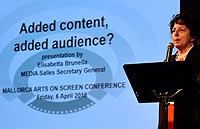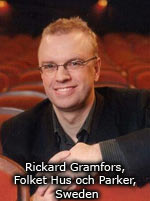Culture means markets
One of the novelties that digitization brings to movie theatres and their audiences is so-called added content or alternative content or event cinema. It ranges from music - whether opera or pop concerts - to theatre, and from ballet to the arts. Thanks to the digital big screen, the content is often connected by satellite transmission, which adds the thrill of a live event, bringing it to a far wider audience than is to be found in the traditionally established venues where these performances and cultural events originate: the Milan Scala, the Uffizi, the Fenice, the Vatican Museums, to quote only a few of the great names that have brought worldwide prestige to Italy and its culture, and which continue to do so.
And if, on the one hand, this content broadens the range of choice offered to cinemagoers, on the other hand, it represents a growing business opportunity and image for the whole of the cinema chain, from producers to exhibitors. This becomes clear in the statistics collected by MEDIA Salles on three of the leading European cinema markets: France, United Kingdom and Italy. In these countries, between 2010 and 2017, box office from added content grew by around 300%, from 13.5 million euros to a little under 54 million. If the incidence on total box office may seem limited in overall terms - varying from approximately 1% in France to 2 - 2.5% in Italy and the UK, according to the year - the average ticket price for added content is very attractive: in 2007 in Italy it was 8.8 euros - whilst a ticket to the cinema cost an average 6 euros - and in France as much as 15.86 euros, compared to 6.6. The mix of products going under the name of added content makes this new offer particularly suited for drawing different audiences and satisfying the tastes and trends of the European public. Whilst in France there is a preference for drama (three titles by the Comédie Française earned the main box office in 2017), in Italy the most successful content has consisted in concerts of pop music (which are classified in the top three places). A similar trend is recorded in Hungary, where this type of concert came in first and second place, followed by art documentaries. If a ballet and an opera (in this order) were the box-office champions of Portugal and Cyprus in 2017, in the United Kingdom the theatre wins (with 4 out of 5 of the top box office places). Even more interesting is the surprising classification by nationality. In 2017 , in the six countries that provided their figures (France, United Kingdom, Italy, Hungary, Portugal and Cyprus), a total of 16 European and two U.S. productions came in first, second and third place in the classification of added content. If we look at a similar classification for films, we see the United States appear 15 times, compared to 3 times for Europe.
, in the six countries that provided their figures (France, United Kingdom, Italy, Hungary, Portugal and Cyprus), a total of 16 European and two U.S. productions came in first, second and third place in the classification of added content. If we look at a similar classification for films, we see the United States appear 15 times, compared to 3 times for Europe.
As emerged at the Mallorca Arts on Screen Conference, where MEDIA Salles presented an overview of the market for added content in Europe, this new sector is offering interesting opportunities to authors, cultural institutions and businesses that address a public in search of quality at the cinema.
The role of Italy
The scenario is frequented by companies that in the space of only a few years have become brand landmarks in the sector of added content, such as RaiCom, Skytv and Nexo Digital. Alongside these giants, the fieldwork is carried out by the local exhibitors and distributors who have encouraged and maintained the interest of spectators - even in small, put-of-the-way or even far distant places in Italy - with a passion for Bel Canto and appreciation of artists from the Bel Paese.
An example comes from the Cinema Heerenstraat in Wageningen, forty thousand inhabitants one hundred kilometres from Amsterdam and fifty from the German border: by joining the Artsincinema.nl programme offered by the distributor ABC, in May a season of art documentaries produced in Italy began, ranging from Caravaggio - L’anima e il sangue (Caravaggio - The Soul and the Blood), to Botticelli - Inferno.
"For years we have been showing our audiences content that offers pride of place to Italian Art, through the great names of architecture, painting and sculpture, particularly from the Renaissance and Baroque periods. But we’ve noticed that our public is also interested in what we might define the ‘Italian lifestyle’: and so, for example,  we screened a documentary on the Scala Opera House and another on the Ferrari," says Rickard Gramfors, of Folkets Hus och Parker. This circuit, which counts over 250 cinemas, has a network that covers Sweden and, for this pioneer of the shift from 35mm to the new technology, added content is the feather in its cap in the context of a strategy that aims to offer films, cultural content and live shows which are traditionally a prerogative of big cities, to small towns and villages, as well. Over the years FHP’s programming has included many productions distributed by Nexo Digital, from those on the Uffizi to the Papal Basilicas of Rome and from Botticelli to Caravaggio. Alongside these, to continue cultivating the "Italian" trend, they have added documentaries produced abroad, such as Pompeii live, on the exhibition organized by the British Museum in collaboration with the Archaeological Office of Naples and Pompeii, and Michelangelo by Phil Grabsky, another "trailblazer" of culture on the big screen.
we screened a documentary on the Scala Opera House and another on the Ferrari," says Rickard Gramfors, of Folkets Hus och Parker. This circuit, which counts over 250 cinemas, has a network that covers Sweden and, for this pioneer of the shift from 35mm to the new technology, added content is the feather in its cap in the context of a strategy that aims to offer films, cultural content and live shows which are traditionally a prerogative of big cities, to small towns and villages, as well. Over the years FHP’s programming has included many productions distributed by Nexo Digital, from those on the Uffizi to the Papal Basilicas of Rome and from Botticelli to Caravaggio. Alongside these, to continue cultivating the "Italian" trend, they have added documentaries produced abroad, such as Pompeii live, on the exhibition organized by the British Museum in collaboration with the Archaeological Office of Naples and Pompeii, and Michelangelo by Phil Grabsky, another "trailblazer" of culture on the big screen.
In Finland Elise Brandt has changed the path of the family business, making Studio 1,2, 3 in Kuusankoski, a town of twenty thousand inhabitants 150 kilometres from Helsinki, into a cinema that bases a large percentage of its programming on added content, with an eye to Italian productions in particular, as well as a base for its distribution to other Finnish cinemas. "From Italy, we have had a great deal of content, particularly operas from La Scala - from Nabucco to Fidelio - but also from La Fenice, the Teatro Regio of Turin and the Teatro dell’Opera in Rome. They work very well for us, even in a recorded version. In the 2017/2018 season, the Scala’s "Magic Flute" was definitely the best appreciated work. At the end of the summer, we have high hopes of our offer, from Rome, of La Traviata, directed by Sofia Coppola. Our programming from La Scala for 2018/19 will include La gazza ladra (The Thieving Magpie), Don Pasquale and Il ratto dal serraglio (The Abduction from the Seraglio), whilst from La Fenice, we shall present Donizetti’s La favorite.
A slightly different strategy is used by the Arthouse group from Zurich which, with its Kinopera programme in the Piccadilly and Le Paris theatres, focuses mainly on live events, in particular from La Scala, but also from the Teatro Comunale of Bologna, from which La Bohème was screened last January. "Premium price" for live shows, at 42 Swiss francs, includes a glass of prosecco, to give the audience the impression of an Italian theatre foyer.
In the UK Thunderbird Releasing states that the most successful Italian opera has been Sofia Coppola's La Traviata. It was not shown live, however, as technical transmission problems have led cinema exhibitors to prefer prerecorded versions.
Italian opera has been present in Australia for many years, thanks first and foremost to Palace Cinemas, a circuit active in many places, including the country’s five most important cities: Sidney, Melbourne, Brisbane, Perth and Adelaide, where over half the population of Australia is concentrated. The chain offers a season rich in opera and ballet, in which productions by La Scala, the Rome Opera and the Comunale of Bologna have the lion’s share. Is it be a coincidence that the Palace Cinemas’ owner is Antonio Zeccola, an Australian from Muro Lucano, whose father, Giovanni, was an exhibitor in Basilicata up until 1956 - the year he left Italy for the newest of the continents.